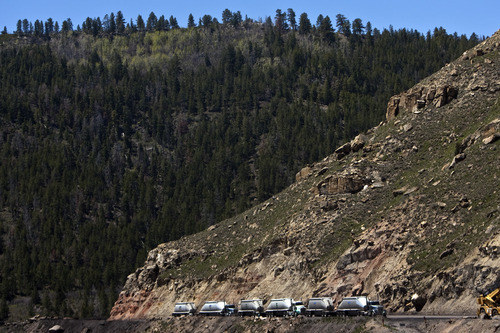This is an archived article that was published on sltrib.com in 2011, and information in the article may be outdated. It is provided only for personal research purposes and may not be reprinted.
Salina • Coal is key to Utah's economy for at least the next generation, Gov. Gary Herbert said on a tour of the state's top power sources Friday.
At least, he said, it is if industry can clean it up.
Without reduced carbon emissions, he warned miners at the massive underground Sufco Mine, national political realities may drive up coal's costs, suppressing Utah's prospects. But he said he is confident the state's universities and regulators have a role in enabling clean-energy industries, including cleaner uses of coal.
"Frankly, we've got to find cleaner ways to have affordable energy," Herbert said after riding 8½ miles into the side of a mountain here, where Arch Coal is grinding 3,000 or more tons a day. Otherwise the federal government likely will impose carbon costs, through a tax or other method.
The Sufco mine supplies nearby power plants and is the origin of roughly half of all electricity used in Utah. Together, Utah's coal mines and some in Colorado and Wyoming provide more than 80 percent of the power used in the state. It's an arrangement that makes Utah's electricity among the cheapest in the nation — less than 6.7 cents per kilowatt hour, compared with about 14 cents in California. But environmental and health advocates say the cheap energy isn't worth the prices paid downwind.
Renewable energy, while growing, accounts for single-digit percentages in Utah's energy portfolio.
Friday's tour was an early attempt at gathering ideas to put Herbert's recently released 10-year state energy plan into practice. The plan calls for market-driven development of everything from natural gas-fired electricity to wood-based gas and solar fields.
Critics have said it's not really a plan, because as yet it offers no clear price changer — tax preferences for renewables, for instance — but Herbert is backing a university-based initiative for innovation. He also backs coal as the great cost reducer, and on Friday told Arch Coal officials that if it's in the state's cost interests, "then, by golly, we ought to be burning more coal, but we ought to be concerned about the environment, too."
"Coal, certainly for the next generation, has a role to play," the governor said later in an interview.
Here in south central Utah, coal's role is bedrock. Sufco alone has 385 employees, mostly living in the dusty service centers of Salina and Richfield. Some 280 local truckers haul 800 loads to Utah power plants and a rail yard at Levan daily.
There are thousands of coal miners in Utah, including about 900 working in St. Louis-based Arch Coal's three mines here. They make, on average, about $75,000, or $112,000 if you add in benefits, the company's regional president, Gene DiClaudio, told the governor.
Sufco, mined since 1941, probably has another 20 years of life, DiClaudio said.
Deep in the mountain, long-wall mining foreman Clayton Dalton was monitoring the 1,000-foot apparatus that strips and ships coal from the seam. Long-wall mining uses computer-driven carbide rotors that churn a few feet of coal from the wall on each pass. The coal falls onto a wet conveyor belt and is sprayed for dust suppression, and Dalton and his crew watch the equipment.
They work in a mechanized cocoon about 25 feet wide and 15 feet high that runs the length of the coal wall. Tree-trunk-sized hydraulic jacks support a steel roof over them, and steel flaps hanging near the wall protect them from spraying coal shards as the grinder moves past. As the whole assemblage digs deeper into the wall, the hollowed space behind the miner collapses, and the mountaintop sags a little.
The ground beneath the miners' rubber boots is a mucky, gray sludge in their helmet lamp beams. The temperature is in the low-60s year-round.
"It's exciting work," Dalton, a 31-year Sufco veteran, shouted over the machinery's buzz. "It's kind of like being a frontiersman. Nobody's ever walked here before. It's like walking on the moon."
More than that, he said, it's work that "keeps the world going."
It's no surprise that Herbert was quick to visit coal producers after releasing his plan this spring, said Utah State University political scientist Michael Lyons. It's politically safe in a conservative state that likes resource jobs, he said.
"It's very clearly designed to demonstrate support for the development of coal," Lyons said. "It's not at all surprising that the governor would indirectly be endorsing the more intense use of coal to meet the energy needs."
Lyon is skeptical that any state energy policy can make significant shifts in a market that's driven by international demand, though. It may be that Utah will move away from coal because that international demand, coupled with environmental costs, drives up fossil fuel costs and spurs alternative technologies, he said.
Terry Marasco, of the Utah Clean Air Alliance, said his group submitted numerous health studies to the governor's planning team, but the plan did not reference their data on coal's health costs.
"Coal being the worst polluter, [that] tells the citizens that the government is more concerned about revenue than health issues," Marasco said.
Herbert also toured Rocky Mountain Power's Huntington coal-fired power plant, which is supplied by conveyor belt from the Deer Creek Mine 2 miles away. The steam turbines there provided enough power for 666,000 homes last year, company officials told him.





